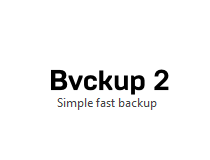

Move backup copies of deleted items into a special archive directory and delete them from there after a grace period. Switch program to run as a system service to allow backups to continue running even when there's no one logged in. Use Windows shadow copying to backup files that are locked for exclusive use by running programs such as web browsers or email clients. Pin a backup to a specific removable device so that it will be run only when this device is present. Speed things up by running computationally intensive tasks such as data hashing on all CPU cores, but scale back when computer is under load.ĭetect files and folders being moved at source and replicate this as a single quick operation on the backup side.Īvoid re-scanning backup location on every run by scanning it once and saving its file index locally. This speeds things up, in many cases dramatically. Reduce the amount of data being moved around by copying modified parts of files only. Run backups at fixed time intervals or only when started manually.Įliminate idling during data transfers by having multiple read and write requests running in parallel. It is also incredibly fast.Ĭontinuously monitor for changes and back them up as soon as they happen.

It is light, uncomplicated and really well designed. Select a pair of folders and Bvckup 2 will make sure that one stays an exact copy of the other.


 0 kommentar(er)
0 kommentar(er)
